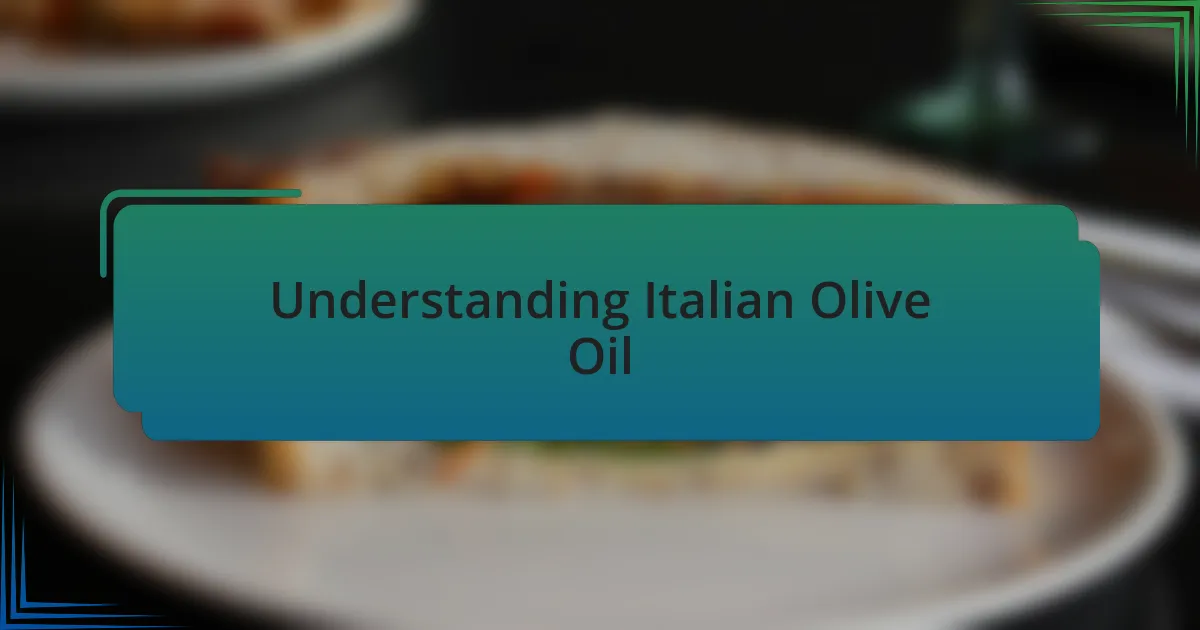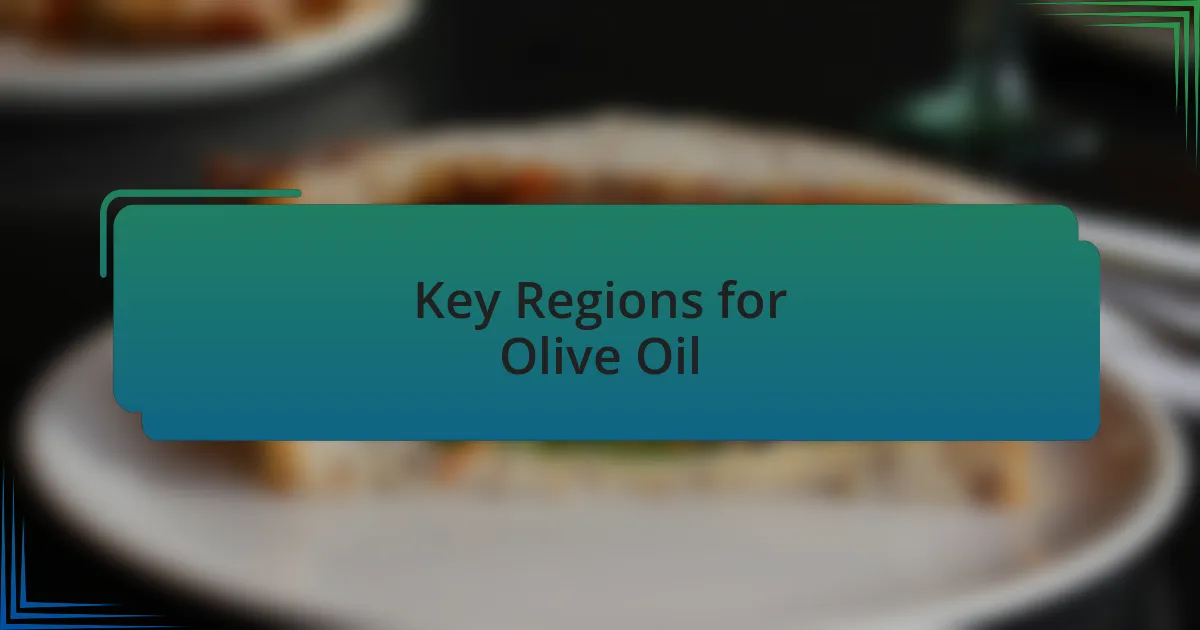Key takeaways:
- Authentic Italian olive oil reflects the region’s heritage and craftsmanship, with distinct flavor profiles influenced by local olives and traditions.
- Quality olive oil should be labeled “extra virgin,” have a fresh aroma, and present a complex flavor profile with fruity, bitter, and peppery notes.
- Regions like Puglia, Tuscany, and Liguria produce oils with unique characteristics shaped by their climate, soil, and cultural practices.
- Effective tasting techniques include using proper glassware, coating the mouth with oil for full flavor, and taking time to savor and reflect on the tasting experience.

Understanding Italian Olive Oil
Understanding Italian olive oil goes beyond just the taste; it’s about the history and craftsmanship behind it. I recall visiting a quaint Italian farm where the olives were harvested by hand, and I could feel the passion in every drop. How many products can you actually witness being made with such dedication?
The variety of olives used in Italy plays a significant role in the oil’s flavor profile. Each region boasts its own unique cultivars, with some oils being fruity and others robustly peppery. I remember my first tasting experience—each oil told a story of its origin, leaving me wondering: how does one choose the right olive oil for their dish?
Quality is paramount when it comes to authentic Italian olive oil. I once purchased a bottle labeled “extra virgin,” only to find it lacking the depth and freshness of true Italian oils. This experience taught me to consider the harvest date and region, as these details can dramatically influence the quality of the oil I choose. What about you? Have you ever been surprised by the difference between good and great olive oil?

Importance of Authenticity
Authenticity in Italian olive oil ensures that what we’re consuming genuinely reflects the rich heritage of the region. I remember the moment I tasted a fresh batch straight from the mill—it was a burst of flavor that transported me to the sun-drenched hills of Tuscany. It got me thinking: what’s the point of enjoying olive oil if it doesn’t capture this essence?
When an olive oil is authentic, it resonates with the labor and love of the craftsmen who produce it. I once spoke with a local producer who described the meticulous process of extraction, and you could sense his pride in maintaining traditions that have lasted for generations. It made me realize that with every bottle of genuine oil, I’m not just buying a product; I’m supporting a legacy.
Embracing authenticity is essential not only for quality but also for understanding and respecting the Italian culture. How many times have we encountered imitations that fall flat compared to the real deal? That contrast pushes me to seek out and cherish those authentic flavors that tell a story, connecting my meals to the heart of Italy itself.

Key Regions for Olive Oil
When it comes to olive oil, the regions of Italy are like hidden gems, each with its own unique flavor profile. Take Puglia, for example. During my travels there, I was struck by the sprawling olive groves bathed in sunlight. The local oil has a robust, peppery kick, reflecting the rich soil that nourishes those ancient trees. How could I ever forget that tasting session in a family-run farm where every drop felt infused with the land’s spirit?
Tuscany, on the other hand, offers a softer, more harmonious flavor. I distinctly remember sitting at a rustic table overlooking the hills, dipping warm bread into a delicate, fruity extra virgin olive oil. It’s a moment that highlighted how much location influences taste. Can you really grasp the heart of Tuscany without experiencing it through its olive oil? For me, it was like discovering poetry in a bottle.
Then there’s Liguria, where the gentle climate produces a milder, more aromatic oil that enhances the regional cuisine beautifully. I once paired this oil with fresh seafood, and the result was a revelation. It made me wonder: how often do we overlook the significance of a region’s climate and landscape in creating such distinctive flavors? Each region not only crafts its oil based on local traditions, but it also tells a story of the land and its people, drawing you deeper into the Italian culture with every taste.

How to Identify Quality Oil
To identify quality olive oil, first, always look for the label. High-quality oils will proudly state “extra virgin,” which means they are made from the first pressing of olives and have a low acidity level. I remember walking through an olive oil shop in Florence, where the vibrant labels caught my eye. Each bottle told a story of origin and quality, immediately drawing me to those that were clearly marked.
Next, don’t underestimate the importance of aroma. Quality olive oil should invite you in with a fresh, grassy scent. I recall lifting a bottle to my nose while in a local restaurant, letting the fragrant notes waft up. It was an eye-opening moment, revealing how a simple sniff could set the stage for the taste to come. Can you imagine how much is communicated through scent alone?
Finally, taste is paramount. A premium olive oil should be complex, with a balance of fruity, bitter, and peppery notes. I’ll never forget my first taste of a robust oil from Sicilia; it had an intense peppery finish that lingered delightfully on my palate. It made me ponder: isn’t it fascinating how a single sip can transport you to sun-drenched fields and ancient trees? Quality olive oil truly has a way of encapsulating a world within its flavors.

Tasting Techniques for Authentic Flavors
When tasting olive oil, one effective technique is to use the proper glassware. I learned that a small, dark glass helps to concentrate the aroma, enhancing the experience. As I swirled the olive oil in my hand, warming it slightly, I could almost feel the excitement bubble up inside me, eager to explore the fragrances hiding within. Have you ever noticed how the right glass can elevate something as simple as oil into an aromatic adventure?
Another technique I find invaluable involves taking a small sip and letting the oil coat your mouth. This practice helps to reveal the oil’s full flavor profile. I remember a tasting session in a quaint Italian villa, where I took a sip of a delicate oil and felt the flavors unfold. The notes weren’t just singular; they danced together, creating a harmonious melody that left me craving more. Isn’t it magical how one taste can reveal layers you never knew existed?
Lastly, never rush the assessment process. Allow the oil to breathe, inhale the scents, and savor each sip, as I often remind myself during tastings. One particularly memorable experience was when I took my time to truly reflect on an oil’s bitterness and pungency. I discovered that these characteristics are not flaws, but rather signs of a robust, authentic oil. How often do we rush through experiences, missing out on their deeper meanings? Taking a moment to pause can transform tasting into a rich discovery.